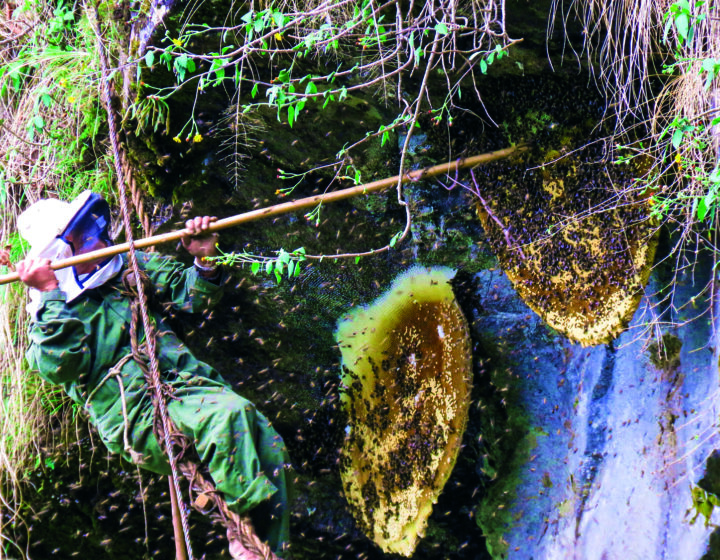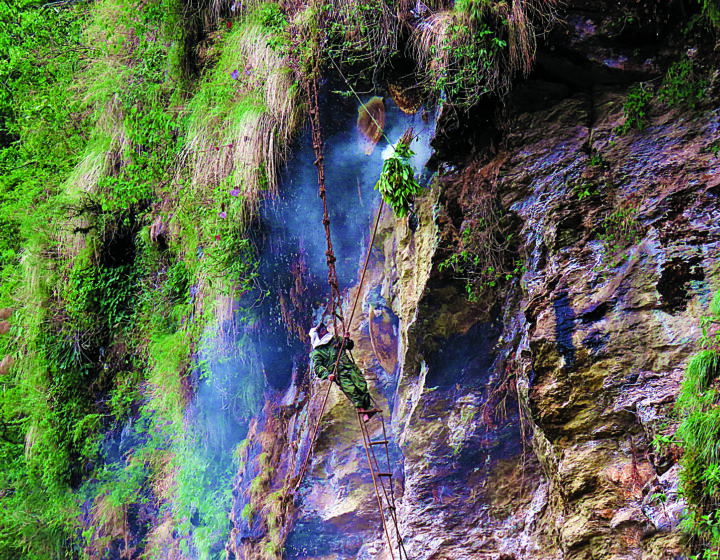
Aside from the massive Himalayas, Nepal is also known for its heavenly pure honey, which is made by the Himalayan giant bees “Apis Laboriosa” and is believed to have medical properties. This high Himalayan honey is also known as “Red Honey” because it comes from a rhododendron whose red flower contains grayanotoxins that give toxicity to its honey. The main queries are who hunts these wild bees and how they hunt.
The most amazing part of the honey collection is the risk and adaptation of no protective tools by honey hunters in Nepal while climbing and collecting honey from those high cliffs. If you’ve ever heard of honey-seeking excursions, there’s no better place to go than Nepal. The sight of honey hunting in real life is fascinating. If you want to be a part of the hunting group and see these courageous people risk their lives to take honey from wild bees and you prefer trekking, this is the trip for you. You will hike in the lap of Annapurna and witness the hunters execute their work with ease, leaving you astounded by their abilities, bravery, and hospitality.
The Best Location for Honey Hunting in Nepal
Honey hunting in Nepal is mostly done by the Gurung and Magar ethnic groups in the Annapurna area. Honey hunting has its own significance among these cultures; each year, at the start of the spring or fall season, the local shaman (priest or tribal leader) of the area picks an auspicious date for honey collecting. Tuesday is a good day, but the 8th, 11th, 23rd, 26th, and 30th days of a lunar cycle are not. Following that, preparation begins, mostly among the community’s male members.
The locations of honey hunting offer both hiking and hunting options, which is one of the lovely combs for domestic and international tourists The most popular destinations for honey hunting are: Bhujung, Nai Chi, Pasgaon, Naya Gaun, Ludhi, and Dare.
The Honey Hunting Method
It is carried out by skilled locals who swing from cliffs as high as 300 meters using handmade ropes and bamboo ladders. The lead honey hunter collects honey from beehives in a bucket and distributes it to another person. This wild honey was utilized for medicinal purposes in ancient times. It still exists and has significant medical value in the worldwide market. Worship is held right before the hunting to honor the hard work of honeybees and their commitment to human survival.
They go on hunts twice a year, in the spring and in the fall, starting early in the morning. The peasants load up their knapsacks with necessities and set off for the nearest cliff’s base. They start their ascent using only handmade hemp ropes and bamboo ladders. The cliffs are frequently 300 meters tall. The lead honey hunter retrieves honey from beehives, puts it in a bucket, and hands it to another hunter. (Watch the video here.)
Around 3053 kg of honey is generated each year in all 26 of Apis dorsata laboriosa’s nesting locations. Twelve communities are participating in this procedure.
The best time of year to go honey hunting
Honey hunting only takes place during a specific season, so you should be aware of the time of year when honey is being collected so you may increase your chances of running into a honey hunter and witnessing honey hunting.
The two seasons during which the locals mostly hunt for honey distinguish them as hunters at lower and higher altitudes. In the fall, lower altitude hunting lasts 5 days, whereas in the spring it lasts 9 days.
Highlights of Honey-hunting
- Wild honey from the mountains
- The Gurung and Tamang traditional honey hunting grounds.
- The green and aesthetic Gurung and Tamang valleys.






